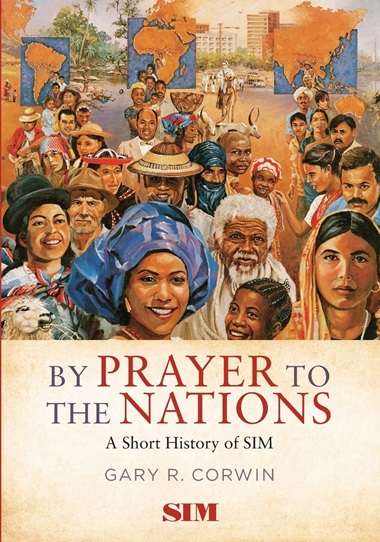 With Mission Fest coming up quickly (February 15 – 17 at Westside Church) I am posting a series on Christianity as a missionary religion:
With Mission Fest coming up quickly (February 15 – 17 at Westside Church) I am posting a series on Christianity as a missionary religion:
1. History of Missions
2. State of World Christianity
3. Specific Areas: Africa
4. Specific Areas: Asia
5. Specific Areas: Latin America
6. Not So Good News
7. New Approaches to Missions
I will look mainly at some of the new books covering these various areas, but will also try to cover a few key themes along the way. It probably goes without saying that I will just scratch the surface of each topic – but I do hope that people will go on to read some of the books, which are of high quality.
III. Specific Areas: Africa
Probably the only really well known missionary to Africa, these days, is David Livingstone. A few others – Mary Slessor, C.T. Studd, Rees Howells, Helen Roseveare – are known in some Christian circles.
But there are so many amazing stories of heroic (and middling and not-so-heroic) missionaries from the West out there yet to be discovered. Not to mention the thousands of African missionaries, virtually unheralded, who spread the gospel around the continent.
It is sobering to think how recently much of the pioneering missionary work took place – much of it less than 100 years ago. The population of Christians in African has grown from less than 10 million in 1900 more than 660 million by 2020.
Here are some recent books which offer some glimpses into how that happened. Some of the write-ups will reflect my thoughts; others (in quotes) will simply be descriptions from the publisher.
- Gary R. Corwin: By Prayer to the Nations: A Short History of SIM (Credo House Publisher, 2018)
By Prayer to the Nations tells how four streams – Sudan Interior Mission, Andes Evangelical Mission, International Christian Fellowship and Africa Evangelical Fellowship – which share roots in the faith missions movement – have taken on a worldwide orientation. SIM is now the mission’s name, but the acronym originally stood for Sudan Interior Mission.
Now, more than 4,000 labourers from some 65 nations work together in over 70 countries.
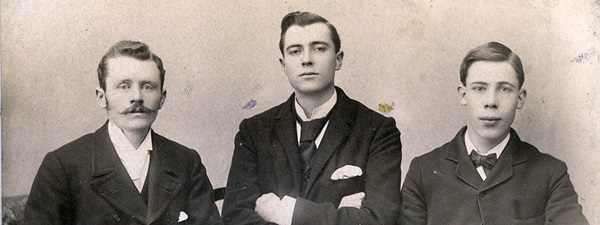
Walter Gowans, Thomas Kent and Rowland Bingham formed Sudan Interior Mission in 1893. By 1894 Gowans and Kent had died of malaria, and Bingham was forced to leave – but continued with SIM.
SIM had strong roots in Canada, formed in 1893 by two Canadians – Rowland Bingham (Baptist) and Walter Gowans (Presbyterian) – and one American, Thomas Kent (Congregational):
[They] had a vision to evangelize the 60 or more million unreached people of the African Soudan (primarily sub-Saharan Sahel region). Unable to interest established missions – most of which said reaching the Soudan was impossible – they set out on their own.
Malaria overtook all three. Gowans and Kent respectively died of dysentery and fever in 1894, and Bingham returned to Canada one year later. On his second attempt in 1900, he again came down with malaria and was forced to go back home. Unable to return to Africa, Bingham sent out a third team one year later. They successfully established a base about 483 km inland at Patigi [Nigeria] in 1902. From there, the work of Sudan Interior Mission in Africa began.
All but two of the first generation of SIM missionaries were Anglo-North America. Over half still were as of 2016 (including 10 percent from Canada), but now there are sizable contingents from East Asia (7.5 percent), Korea (5.8 percent) and South Africa (3.6 percent).
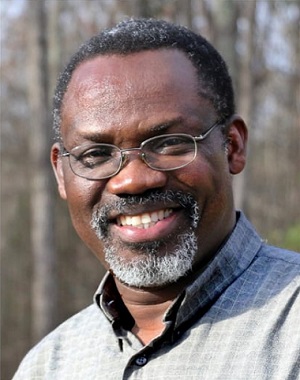
Dr. Joshua Bogunjoko is the current International Director of SIM.
Dr. Joshua Bogunjoko is the current International Director of SIM. Sent by their church in Nigeria, Joshua and his wife, Joanna, both medical doctors, were among the first missionaries sent outside of Nigeria by the Evangelical Mission Society. They joined SIM in 1995.
He was a keynote Missions Fest speaker in 2021. Here is a portion of an article by him (posted on Church for Vancouver at the time) about a couple who have devoted their lives to reaching fellow Somalis, and others:
While in Europe, God called them to join SIM – our first Somali members after 80 years of prayer and service. Last year they relocated to Ethiopia to help reach Somalis through radio, web and social media.
What would compel someone to go to a difficult place and sustain their presence there?
Many believers have equated the Great Commission to a task that we desire to see “finished.”
But we do not go out into some of the most dangerous and needy places on earth simply to complete a task. We could not sustain ourselves for years in difficult locations in order to tick a box. Only one motivation can keep our feet grounded in communities where Christ is least known. That motivation is love.
We go and we stay because we have experienced the love of God; our strength and joy are renewed in communing with Him. Out of that relationship comes love and compassion for those we serve, those with the potential to be in relationship with God too.
Today, about 77 percent of all missionaries in the world are serving in locations considered reached with the gospel. Only about 19 percent serve in unevangelized areas. A mere 3 percent are in completely unreached areas – areas with no known believers and no active church planting efforts underway.*
Jesus told us the parable of the shepherd who searched for one lost sheep among 100. And yet there are communities today where 99 or 100 of the sheep are lost, and not a single shepherd is yet available to search for them.
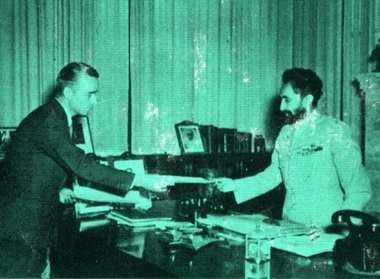
Among other things, Robert Thompson was a special assistant to Ethiopia’s Emperor Haile Selassie. Image from Facebook page devoted to ‘Dr. Bob’: https://www.facebook.com/DrRobertNThompson/
A couple of local connections to SIM:
Robert (Bob) Thompson was pictured as part of the first General Council of SIM in 1957. The Trinity Western University Archives include a series of “textual records documenting Thompson’s service with Sudan Interior Mission in Ethiopia.”
Another entry covers his ‘biographical history,’ illustrating the kind of skills and big picture thinking brought back by missionaries:
During World War II he served as an instructor in the Commonwealth Air Training Plan. In 1943 the family [Bob, Hazel and eight kids!] relocated to Ethiopia with the Sudan Interior Mission. He was seconded to the Ministry of Education until 1952, and acted occasionally as a diplomat for Ethiopia from 1953 to 1958, when the family returned to Canada.
He was president of the Social Credit Party of Canada from 1960 to 1961, its national leader from 1961 to 1967, and Member of Parliament (MP) for Red Deer (Alberta) from 1962 to 1972. During the 1970s and 1980s he served as an administrator and instructor (Political Science) at Trinity Western University in Langley, BC.
Doris Irene Jacobson (1924 – 2017) also served with SIM. Growing up as one of seven children, her parents dedicated her to the Lord’s work when she was miraculously restored after having become gravely ill as a toddler. She joined SIM in 1949, expecting to go to Nigeria, but ending up in Ethiopia by way of Aden, where she met her husband.
Here is a portion of her obituary on the McKenzie Funeral Services site in West Vancouver (she and her husband retired in this area):
Of their 15 years in Ethiopia most was invested in teaching God’s Word in the rural, mountainous province of Kambatta, 200 miles south of Addis Ababa – a full day’s journey over muddy trails and rickety bridges. There, they helped establish the first public schools, promoted literacy, offered health care, nurtured the developing churches and established theological education. . . . Hundreds of churches in the Kambatta area continue to proclaim new life in Christ.
Her service was held at Willingdon Church December 12, 2017.
Another book covering some of the same ground, but which I have not seen, is Transforming Africa’s Religious Landscapes: The Sudan Interior Mission (SIM), Past and Present. Gary Corwin is one of several editors.
- E. Paul Balisky: Thomas A. Lambie: Missionary Doctor and Entrepreneur (Wipf & Stock, 2020)
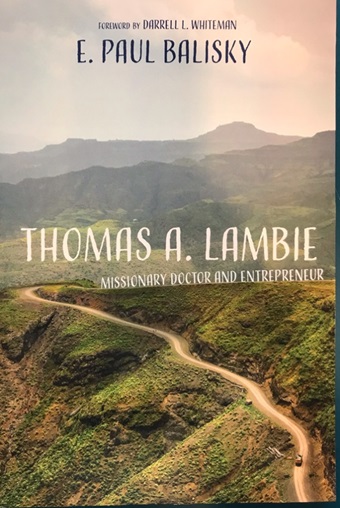 “Dr. Thomas A. Lambie was called a “loose cannon” by his Presbyterian missionary colleagues in British Sudan in 1907 because of his energy, vision and spiritual fervor.
“Dr. Thomas A. Lambie was called a “loose cannon” by his Presbyterian missionary colleagues in British Sudan in 1907 because of his energy, vision and spiritual fervor.
“Through combined gifts of diplomacy and medical prowess, Lambie, together with two missionary colleagues, launched the Sudan Interior Mission in Ethiopia in 1927. The goal of this enterprise was to evangelize the primal religionists of southern Ethiopia.
“During 10 years of pioneering mission efforts by Lambie and nearly one hundred SIM cohorts, a young church of nearly 50 baptized believers was formed. The missionaries were then evicted from Ethiopia by the invading Italians in 1936.
“This modest beginning became the foundation for what is today the vibrant Ethiopian Kale Heywet Church, the largest evangelical denomination in Ethiopia.” [ With 11,000 local Churches a membership of more than 10 million.]
One interesting element of the story is Lambie’s role as personal physician and friend with Ras Tafari (crowned Emperor Haile Selassie I in 1930) – quite close, then broken due to the stresses of the Italian occupation.
And also with the one surviving founder of SIM:
Thomas Lambie and Rowland Bingham traversed hundreds of miles together – in 1930, 1934 and 1937 – by mule and horse in Abyssinia and by vehicle in Sudan . . . The purpose of [the 1937] trip was to place Abyssinia-based SIM missionaries, who had been evicted by the Italian Fascists, among unreached people groups of southern Sudan.
There is even a local connection to Thomas A. Lambie. Author Paul Balisky and his wife Lila were missionaries in Ethiopia from 1967 – 2005. One of their sons, Loren, lives here in Vancouver and is co-founder of Kinbrace, which is a leading light in welcoming refugee claimants and all newcomers.
- Ian Campbell: Holy War: The Untold Story of Catholic Italy’s Crusade Against the Ethiopian Orthodox Church (Hurst and Company, 2021)
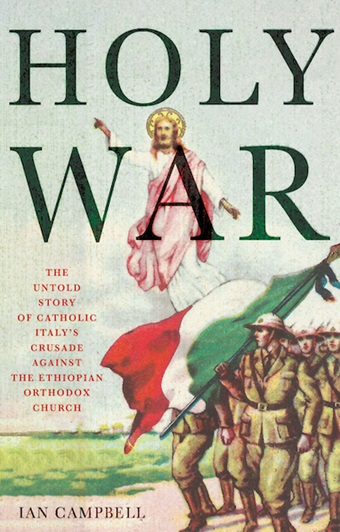 “In 1935, Fascist Italy invaded the sovereign state of Ethiopia – a war of conquest that triggered a chain of events culminating in the Second World War.
“In 1935, Fascist Italy invaded the sovereign state of Ethiopia – a war of conquest that triggered a chain of events culminating in the Second World War.
“In this stunning and highly original tale of two Churches, historian Ian Campbell brings a whole new perspective to the story, revealing that bishops of the Italian Catholic Church facilitated the invasion by sanctifying it as a crusade against the world’s second-oldest national Church.
“Cardinals and archbishops rallied the support of Catholic Italy for Il Duce’s invading armies by denouncing Ethiopian Christians as heretics and schismatics, and announcing that the onslaught was an assignment from God.
“Campbell marshals evidence from three decades of research to expose the martyrdom of thousands of clergy of the venerable Ethiopian Church, the burning and looting of hundreds of Ethiopia’s ancient monasteries and churches and the instigation and arming of a jihad against Ethiopian Christendom, the likes of which had not been seen since the Middle Ages.
“Finally, Holy War traces how, after Italy’s surrender to the Allies, the horrors of this pogrom were swept under the carpet of history, and the leading culprits put on the road to sainthood.”
Holy War was among Foreign Affairs’ best books of 2022.
I have not written much about Roman Catholic missions in this piece; this unholy crusade was not typical of most of their mission activity.
- Mark Shaw & Wanjiru M. Gitau: The Kingdom of God in Africa: A History of African Christianity (Langham Publishing, 2020)
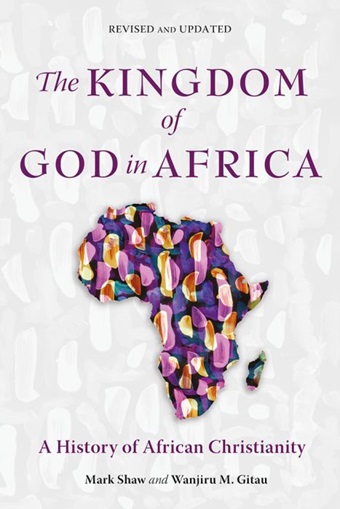 “African Christianity is not an imported religion but rather one of the oldest forms of Christianity in the world. In The Kingdom of God in Africa, Mark Shaw and Wanjiru M. Gitau trace the development and spread of African Christianity through its 2,000 year history, demonstrating how the African church has faithfully testified to the power and diversity of God’s kingdom.
“African Christianity is not an imported religion but rather one of the oldest forms of Christianity in the world. In The Kingdom of God in Africa, Mark Shaw and Wanjiru M. Gitau trace the development and spread of African Christianity through its 2,000 year history, demonstrating how the African church has faithfully testified to the power and diversity of God’s kingdom.
“Both history students and casual readers will gain greater understanding of how key churches, figures and movements across the continent conceptualized the kingdom of God and manifested it through their actions. The only up-to-date, single-volume study of its kind, this book also includes maps and statistics that aid readers to absorb the rich history of African Christianity and discover its impact on the rest of the world.”
Diane Stinton, Dean of Students and Associate Professor, Mission Studies at Regent College wrote of the book: “What a timely revision given Africa’s rise to prominence within World Christianity! Meticulous historians and masterful narrators, the authors’ interpretation through the lens of the kingdom of God showcases the study of World Christianity at its best.”
Wanjiru Gitau wrote ‘The Lifework of Andrew Walls for African Theology: Re-Centering Africa’s Place in Christian History’ for Lausanne Global Analysis.
- Emmanuel A.S. Egbunu: Pathfinders for Christianity in Northern Nigeria, 1862 – 1940 (Wipf & Stock, 2021)
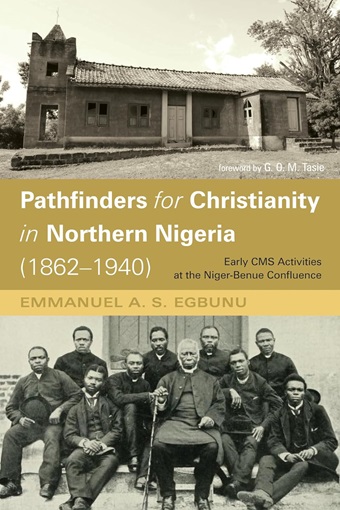 The Anglican Bishop of Lokoja in Nigeria wrote Pathfinders for Christianity in Northern Nigeria, 1862 – 1940 “to reconstruct the legacy of the Church Missionary Society (CMS), both Western and African,” in his area.
The Anglican Bishop of Lokoja in Nigeria wrote Pathfinders for Christianity in Northern Nigeria, 1862 – 1940 “to reconstruct the legacy of the Church Missionary Society (CMS), both Western and African,” in his area.
Located at the confluence of the Niger and Benue Rivers, the Lokojo region was at the borderland of the Christian-influenced south and the north, dominated by Islam and traditional religion.
A leading figure in the story is Samuel Crowther (1809 – 1891), described in the Dictionary of African Christian Biography by Andrew Walls (whose last book I wrote about in Part I) as “probably the most widely known African Christian of the 19th century.”
From the Yoruba area in west Nigeria, Crowther was captured by Muslim slave traders at age 12, but then freed from a Portuguese slave ship and returned to Sierra Leone.
Through the (Anglican) CMS, he gained an education and was baptized. He worked among his own people as a missionary from 1843 – 1851 and then became bishop of the Niger territory in 1864.
Egbunu concluded by saying:
The attitude of Samuel Ajayi Crowther and his workers toward the leadership of the Muslim community laid a solid foundation for religious harmony. They did not condemn Muslims they met, but rather engaged in respectable dialogue – including presenting Arabic Bibles to the traditional rulers to help them gain a clearer perspective of the Christian faith they were introducing.
G.O.M. Tasie, retired Professor of Church History at Jos, Nigeria, wrote in the Foreword:
Significantly, Dr. Egbunu has demonstrated how, if only Bishop Crowther’s carefully thought-out templates for cordial interreligious relationships (especially among Christian and Muslim adherents) had been heeded, the ugly interreligious disharmony, as we notice in Nigeria today, could have been much minimized in favor of better understanding and cooperation.
Last year I wrote about Jan and Fran Boer, who spend 30 years as missionaries in Nigeria and now live in Vancouver. I noted, “Not only does [their book] Every Square Inch cover Christian-Muslim relations in some detail (both in terms of personal contacts and in theory), but Jan has written an eight-volume, 2,700 page (!) collection on Christian-Muslim relations.
- Kimberly D. Hill: A Higher Mission: The Careers of Alonzo and Althea Brown Edmiston in Central Africa (University Press of Kentucky, 2020)
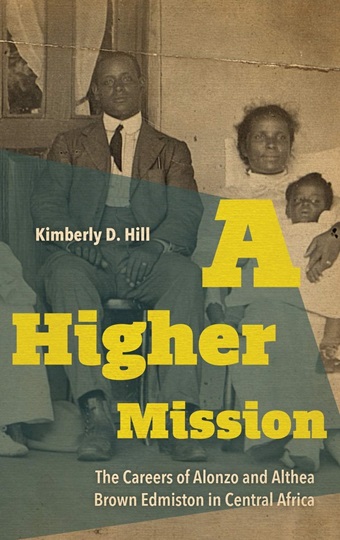 “They discovered a unique kinship amid the country’s growing human rights movement and used their familiarity with industrial education, popularized by Booker T. Washington’s Tuskegee Institute, as a way to promote Christianity and offer valuable services to local people.
“They discovered a unique kinship amid the country’s growing human rights movement and used their familiarity with industrial education, popularized by Booker T. Washington’s Tuskegee Institute, as a way to promote Christianity and offer valuable services to local people.
“From 1902 through 1941, the Edmistons designed their mission projects to promote community building, to value local resources and to incorporate the perspectives of the African participants.
“They focused on childcare, teaching, translation, construction and farming – ministries that required constant communication with their Kuba neighbors. Hill concludes with an analysis of how the Edmistons’ pedagogy influenced government-sponsored industrial schools in the Belgian Congo through the 1950s.
“A Higher Mission illuminates not only the work of African American missionaries – who are often overlooked and under-studied – but also the transnational implications of black education in the South.
“Significantly, Hill also addresses the role of black foreign missionaries in the early civil rights movement, an argument that suggests an underexamined connection between earlier 19th century Pan-Africanisms and activism in the interwar era.”
- Steven Paas: Johannes Rebmann: A Servant of God in Africa Before the Rise of Western Colonialism (WIpf & Stock, 2018)
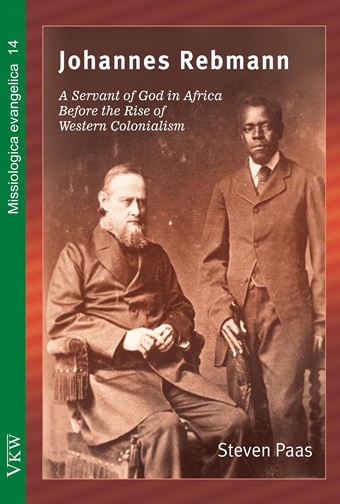 “[Johannes Rebmann] is the revised and enlarged second edition of a biography of the missionary and linguist Johannes Rebmann (1820 – 1876), a Christian from Germany who worked in 19th century East Africa.
“[Johannes Rebmann] is the revised and enlarged second edition of a biography of the missionary and linguist Johannes Rebmann (1820 – 1876), a Christian from Germany who worked in 19th century East Africa.
“Rebmann was deeply influenced by the movement of Pietism in his homeland Württemberg. He was trained to be a missionary in Basel, Switzerland, for the Anglican Church Missionary Society (CMS).
“From its base in London the CMS sent him to the Muslim-ruled and slavery-ridden Mombasa area of present-day Kenya. There he stayed for 29 years before returning home to Gerlingen near Stuttgart, blind and sick, soon to die. Rebmann was a faithful witness of Christ in word and deed. He experienced a lot of suffering and opposition, but was instrumental in establishing the Church in East and Central Africa.
“His lexicographical work facilitated succeeding missionaries. He compiled vocabularies of the Swahili and N(y)ika languages. Together with Salimini, a slave captured near Lake Nyasa (now Lake Malawi) by the Swahili Arabs, he made a dictionary of the ‘Kiniassa’, an important language in Central Africa, which is now usually called Chichewa.”
In a nice coincidence, the author’s son, Dr. Stefan Paas will be in Vancouver for a couple of events in early May: As keynote speaker for the Cultivate: Church Planting Conference, May 2 – 4 at St. Andrew’s Hall, and for a free evening lecture, May 3 at Kerrisdale Presbyterian Church: Pilgrims and Priests: Christian Mission in a Post-Christian Society
- Jeremy Best: Heavenly Fatherland: German Missionary Culture and Globalization in the Age of Empire (University of Toronto Press, 2021)
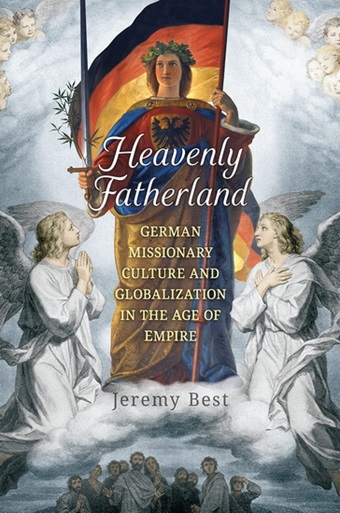 “Motivated by a theology that declared missionary work was independent of secular colonial pursuits, Protestant missionaries from Germany operated in ways that contradict current and prevailing interpretations of 19th century missionary work.
“Motivated by a theology that declared missionary work was independent of secular colonial pursuits, Protestant missionaries from Germany operated in ways that contradict current and prevailing interpretations of 19th century missionary work.
“As a result of their travels, these missionaries contributed to Germany’s colonial culture. Because of their theology of Christian universalism, they worked against the bigoted racialism and ultra-nationalism of secular German empire-building.
“Heavenly Fatherland provides a detailed political and cultural analysis of missionaries, mission societies, mission intellectuals and missionary supporters.
“Combining case studies from East Africa with studies of the metropole, this book demonstrates that missionaries’ ideas about race and colonialism influenced ordinary Germans’ experience of globalization and colonialism at the same time that the missionaries shaped colonial governance.
“By bringing together religious and colonial history, the book opens new avenues of inquiry into Christian participation in colonialism. During the Age of Empire, German missionaries promoted an internationalist vision of the modern world that aimed to create a multinational, multiracial “heavenly Fatherland” spread across the globe.”
